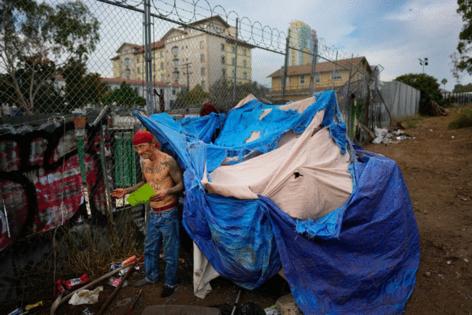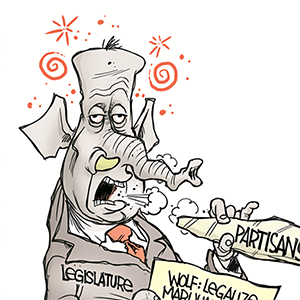Shelter requests surged after San Diego began clearing freeway camps. Almost all failed
Published in News & Features
Andrew Shields doesn’t want to be sleeping next to Interstate 5.
He dislikes that his bed consists of a foam block balanced on a coffee table, both of which are visible to people entering downtown. He knows that living outside makes it difficult for him to kick a drug addiction or take medication for his schizophrenia.
There’s just one problem: He’s unable to find an open shelter bed.
“I’ve been trying for six weeks,” Shields, 56, said Wednesday from his hillside encampment. “I can’t get in.”
Requests for shelter have risen significantly in the city of San Diego since local officials got permission to clear encampments on state land. Yet a lack of spots in the region’s overwhelmed shelter system means almost all of those pleas — about 93% — recently failed.
The disparity not only leaves many people sleeping outside but potentially increases the chances that somebody refuses help the next time it’s offered because they’ve lost faith that services are available. All the while, area leaders are trying to do more with less as budgets shrink at seemingly every level of government.
Pressure has been building in San Diego’s shelter system for years.
In the summer of 2023, the City Council passed a camping ban that boosted penalties for sleeping on sidewalks. Requests for shelter immediately spiked. Most did not lead to someone getting a bed. Some weeks saw the city’s success rate hover around 20%, meaning that only around 1 out of every 5 pleas for aid resulted in a person getting under a roof, according to the San Diego Housing Commission.
Leaders in recent years have expanded affordable housing and created new shelters, including facilities for homeless women, children and young adults. Yet other places closed. That list includes the Rosecrans Shelter in the Midway District, which shut down after the city and county couldn’t agree on who should pay for what. Another plan to turn an empty warehouse into a 1,000-bed facility floundered amid concerns about the cost.
During the last fiscal year, which ended in June, the city’s success rate fell to 12%.
Some individuals displaced by the camping ban simply moved their tents next to freeways. That land is generally under state jurisdiction and therefore off-limits to San Diego officials. At least, it was off-limits until July, when San Diego and the California Department of Transportation signed an agreement allowing local police, cleaning crews and outreach workers onto the property.
Elected leaders have hailed that deal as a game-changer that should be adopted by other cities. San Diego crews have already cleared more than 180 freeway encampments and 50-plus people living at those sites accepted some form of shelter, officials previously said.
Those success stories, however, may be getting rarer.
The housing commission recently reported that shelter requests have surged in recent months. October alone saw 2,940 pleas for a bed. “This is quite substantial,” Casey Snell, a senior vice president at the commission, said this month at a public hearing. “It’s not an anomaly or an outlier.”
But of those 2,940 shelter requests, only 206 succeeded. That’s a success rate of 7%.
Commission and city officials have so far declined to speculate as to why the demand has shot up so dramatically, pledging only to study the issue further. But the numbers have nonetheless risen repeatedly since July, when the Caltrans agreement was finalized.
“The City and its partners continue to be committed to finding ways to reduce the length of stay” in area shelters, spokesperson Matt Hoffman wrote in an email. At the moment, people using those beds wait an average of 240 days before finding a permanent place to live, he added. “More affordable and supportive housing is needed to help increase the outflow.”
San Diego currently has about 1,600 spots in traditional shelters and around 760 tents at two designated camping areas near Balboa Park, a total that likely won’t change anytime soon. The Office of the Independent Budget Analyst wrote earlier this year that a drop in state support in particular means the city must largely make do with the beds it already has.
Hoffman, the San Diego spokesperson, noted that other homelessness-related programs may ease the pressure on shelters. Those include initiatives like prevention, which often helps families pay rent, and diversion, a strategy that generally offers residents one-time payments to cover emergency expenses. Both have shown considerable promise.
One person can ask for shelter multiple times, which means that October’s 2,940 bed requests were not necessarily made by 2,940 separate individuals. And sometimes people ask for a spot and then don’t show up to claim it, police officers and local officials have said. But housing commission statistics show that the majority of requests fail because beds aren’t available.
The increase in demand could additionally be influenced by factors besides encampment sweeps.
For example, a court settlement says officers can’t punish residents for living out of cars if there’s nowhere else to go, and for a long period all of San Diego’s safe parking lots were mostly full. That changed earlier this year with the opening of the H Barracks site near the airport, and police have since resumed citing people found sleeping in their vehicles.
While space remains at safe lots — those sites are not included in the shelter request statistics — many areas are only open overnight. RV owners especially have said they can’t always afford the gas to move in and out every day.
Plus, more people in San Diego County continue to lose a place to stay each month than the number of homeless individuals who find housing, according to the Regional Task Force on Homelessness.
Shields, the man in the freeway encampment, said he’d tried all the methods he knew to get a bed: Calling 211, flagging outreach officers with the San Diego Police Department. The San Diego Union-Tribune confirmed that his name isn’t on the sex offender registry, nor do there appear to be any criminal charges against him in local courts, meaning he should be eligible for most types of shelter.
Shields said a friend in a wheelchair recently had a similar experience asking for help. “She just finally gave up.”
_____
©2025 The San Diego Union-Tribune. Visit sandiegouniontribune.com. Distributed by Tribune Content Agency, LLC.







Comments